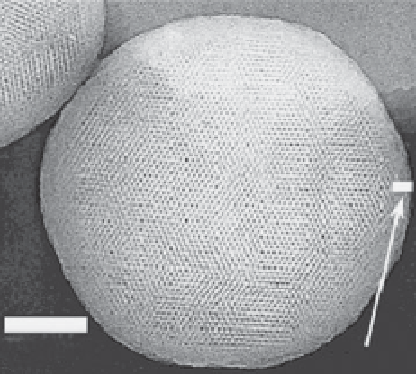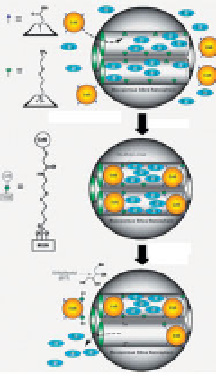Biomedical Engineering Reference
In-Depth Information
following points lay out the fundamentals necessary for mesoporous silica
to be feasible for drug delivery
in vivo
: a) tunable particle size from 50 to 300
nm allowing a facile endocytosis by living animal and plant cells without
any signifi cant cytotoxicity; b) an ordered, uniform and tunable pore size,
usually 2 ~ 6 nm, which is very easy to adjust for loading different size drug
molecules and control release kinetics; c) a high surface area and a high pore
volume, typically over 1000m
2
/g and over 0.8 cm
3
/g, respectively, implies
high potential for drug adsorption; d) a silanol-containing surface that can be
functionalized to allow better control over drug loading and release [18-20].
13.3.3.2
Gatekeeper/ Stimuli-Responsive for Controlled Released
Mesoporous silica nanoparticles (MSNP) have been proven to be an
extremely effective solid support for controlled drug delivery on account
of the fact that their surfaces can be easily functionalized in order to control
the nanopore openings. Xiao and coworkers designed pH-responsive car-
riers in which polycations are grafted to anionic, carboxylic acid modifi ed
SBA-15 by ionic interactions [38], poly(N-isopropylacryl amide) (PNIPAm),
to produce sponge-like phases [39]. The controlled-release mechanism of
the system is based on the reduction of the disulfi de linkage between mag-
netic Fe
3
O
4
nanoparticles and the thiol-functionalized silica mesoporous
material by reducing agents such as dihydrolipoic acid or dithiothreitol.
Two examples that represent works on MSN-based applications for
controlled release are shown in Figure 13.3. Lin
et al.
studied the stimuli-
responsive release profi les of vancomycin and adenosine triphosphate
Cds Nanoparticle
Amidation
Disulfide
cleavage
50 nm
11 nm
Figure 13.3
Left: Schematic representation of the CdS nanoparticle-capped MSN-
based drug/neurotransmitter delivery system. The controlled-release mechanism
of the system is based on chemical reduction of the disulfi de linkage between
the CdS caps and the MSN hosts. Right: TEM image of MSN. (Reprinted with
permission from [40])


Search WWH ::

Custom Search